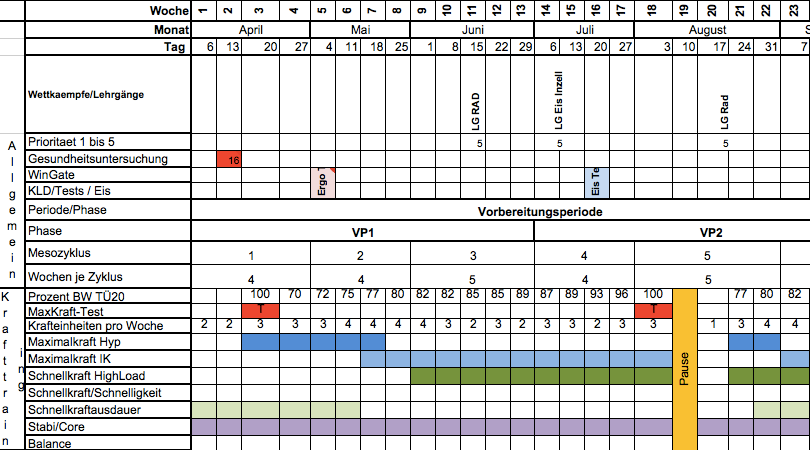What is periodization?
Periodization is advanced training planning. Periodization is the cyclical division of the training program into discrete training phases to maximize progress and success. Periodization means regularly varying the training program and the individual training parameters such as repetitions, sets, speed and rest in phases.
The early origins of periodization date back more than 100 years (Butowskik 1910 / Murphy 2013 / Kotav 1917). In the 1960s, periodization as we know it today was defined by Russian sports scientists, in particular Prof. Leonid Matveyev.
What is wavy periodization
Undulating periodization has its origins in Poland in the 1970s. Volume (accumulation phase) and intensity (intensification phase) are alternated as stressors. This prevents the detraining effect and is ideal for year-round training and sports with a short offseason and long competition season, such as all team sports. For this reason, it is the most intelligent solution for achieving constant and sustainable progress in the fitness and personal training sector.
| stage 1 | stage 2 | stage 3 | stage 4 | stage 5 | stage 6 | |
|
Sentence/ repeat system |
4×8-12 | 4×6-8 | 10×10 | 5×5 | 6×6 | 6×6,6,4,4,2,2 |
| number of exercises | 6-8 | 6 | 2-4 | 2-4 | 4-5 | 4-5 |
| peak intensity | 75% | 78% | 60% | 85% | 80% | 95% |
The wavy periodization
The main advantages of wavy (non-linear) over linear periodization are:
- The constant increase in intensity with linear periodization, and the consequent increase in stress on the nervous system, increases the likelihood of plateau and injury towards the end of the cycle. In contrast, wavy periodization allows the nervous system to regenerate every other phase - the accumulation phase - as the intensity is reduced. And enables more constant and sustainable progress along the way.
- With linear periodization, the constant reduction in volume leads to a loss of hypertrophy as the phases progress. Loss of muscle mass is the most reliable predictor of in-season injury in US college sports, according to a study by the NCAA. Conversely, maintaining muscle mass during the season is an excellent prerequisite for avoiding injuries. The wave-shaped periodization allows the alternation of accumulation phases and intensification phases to maintain muscle mass and, in particular, functional muscle mass in every second phase through higher volume.
Due to the possibility of precisely structuring volume and intensity, wave-shaped periodization is particularly suitable for strength training. While forms of periodization such as block periodization are particularly suitable for sport-specific training of technique and tactics.
Periodization of the set/rep system and the main exercises of the leg training of the Hungarian short track speedskating national team in preparation for the season 2012/13 (offseason April 2012 to October 2012)
| phase | Set/Rep System | main exercises |
| GPP 1 | 4×8-12 | Split squat, lower cable, front foot elevated - back extension, horizontal, KH |
| GPP 2 | 4×6-8 | Split squat, CH – 45° back extension, CH |
| GPP 3 | 10×10 | LH squats, heels elevated |
| SPP 1 | 10×5 | Snatch grip deadlift |
| SPP 2 | 6×6 | LH Squat, Heels Up - LH Romanian Deadlift |
| SSP 3 | 6×6,6,4,4,2,2 | LH Squat Jump – LH squats |
| SSP 4 | 5×5 | Progressive Range Power Clean - LH front squats |
| power | 6×2-4 | Power clean, off the floor |
GPP= General Preparatory Phase, SPP = Specific Preparatory Phase, LH = Barbell, KH = Dumbbell
Each phase has a duration of 2-4 weeks. Within a phase, the set/repetition system and the main exercises are not varied in order to ensure maximum adaptation to the training stimulus.
Conclusion: Periodization is critical to ensure athlete readiness for optimal and maximum performance during training and competition. Waveform periodization is the number one choice in strength training for consistent and sustained gains in muscle size, strength, and explosiveness.
I give further insight into periodization and its use in practice at the YPSI Program Design (Module 3) seminar and the YPSI Advanced Program Design & Periodization seminar .
Good luck using wavy periodization for more consistent training progress!
Image: A glimpse into the periodization of the 2015 offseason by YPSI athlete and short track speed skater Agne Sereikaite, who took bronze at the European Championships that year.

